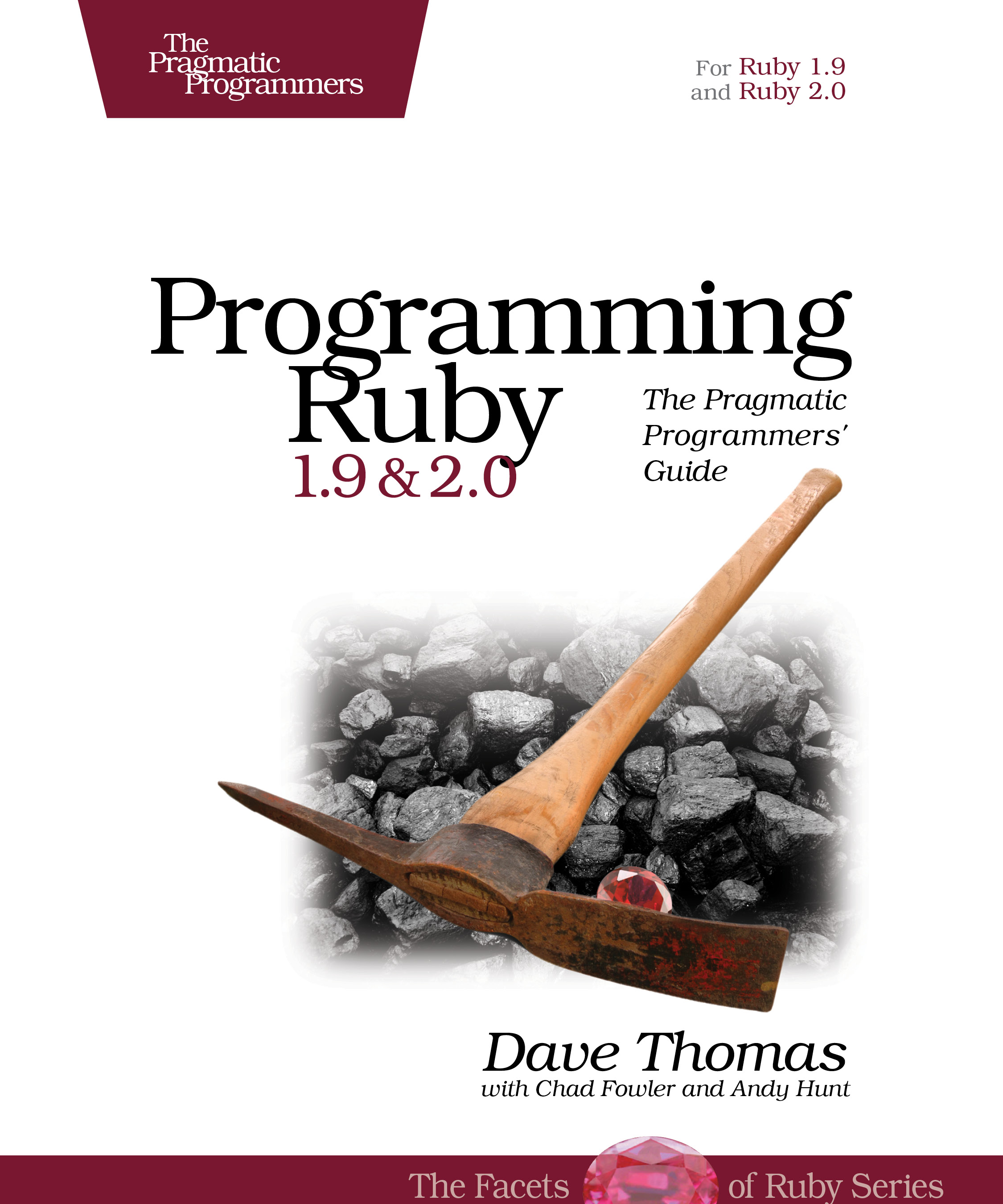Programming Ruby 1.9 & 2.0
The Pragmatic Programmers' Guide
by: Dave Thomas, with Chad Fowler and Andy Hunt
| Published | 2013-06-18 |
|---|---|
| Internal code | ruby4 |
| Print status | In Print |
| Pages | 886 |
| User level | |
| Keywords | ruby, rails, 1.9, 2.0, new edition, scripting, pickaxe, dynamic, dynamic languages, agile, reference, library, ruby library, ruby reference, ruby 1.9, ruby 2.0 |
| Related titles | |
| ISBN | 9781937785499 |
| Other ISBN |
Kindle: 9781680501100 Safari: 9781680501117 Kindle: 9781680501100 |
| Edition | 4 |
| BISACs | COM051010 COMPUTERS / Programming Languages / GeneralCOM051230 COMPUTERS / Software Development & Engineering / GeneralCOM051230 COMPUTERS / Software Development & Engineering / General |
Highlight
Ruby is the fastest growing and most exciting dynamic language out there. If you need to get working programs delivered fast, you should add Ruby to your toolbox.
This book is the only complete reference for both Ruby 1.9 and Ruby 2.0, the very latest version of Ruby.
Description
Would you like to go from first idea to working code much, much faster? Do you currently spend more time satisfying the compiler instead of your clients or end users? Are you frustrated with demanding languages that seem to get in your way, instead of getting the work done? Are you using Rails, and want to dig deeper into the underlying Ruby language? If so, then we’ve got a language and book for you!
Ruby is a fully object-oriented language, much like the classic object-oriented language, Smalltalk. Like Smalltalk, it is dynamically typed (as opposed to Java or C++), but unlike Smalltalk, Ruby features the same conveniences found in modern scripting languages such as Perl and Python.
The combination of the power of a pure object-oriented language with the convenience of a scripting language makes Ruby a favorite tool of intelligent, forward-thinking programmers.
The Pickaxe contains four major sections:
- An acclaimed tutorial on using Ruby.
- The definitive reference to the language.
- Complete documentation of all built-in classes, modules, and methods.
- Complete descriptions of all 97 standard libraries.
This is the reference manual for Ruby, including a description of all the standard library modules, a complete reference to all built-in classes and modules (including all the new and changed methods introduced by Ruby 1.9, 1.9.2, 1.9.3, and 2.0¹). It also includes all the new and changed syntax and semantics introduced since Ruby 1.8. Learn about the new parameter passing rules, local variable scoping in blocks, fibers, and the new block declaration syntax, among other exciting new features.
About Ruby 2.0
Ruby 2.0 is a minor update to Ruby 1.9, unlike the more major updates from Ruby 1.8 to Ruby 1.9.
The major language changes in Ruby 2.0 are the addition of keyword arguments and the change to use UTF-8 as the default source file encoding.
There are a number of additions to the standard library, including:
Enumerator::Lazy, which adds support for lazy access to potentially infinite lists.- Refinements allow you to encapsulate changes to third-party classes, and scope their application to individual source files, preventing your changes from polluting the global application.
You’ll also find that Ruby 2 is faster, and has memory management improvements that make it more server-friendly.
All told, there are over 110 sections of the book that have been flagged and cross-linked to indicate 2.0 content.
Ruby in Fiction
Ruby is the language of choice in Mr. Penumbras 24 Hour Bookstore, a fun novel about books, Google, and a somewhat flakey secret society.
Learn Ruby Online at the Pragmatic Studio
Want to learn how to write object-oriented Ruby programs interactively through engaging videos and hands-on exercises? Check out The Pragmatic Studio’s online Ruby Programming course.
In this online, self-paced course, you’ll learn all the fundamentals of the Ruby programming language, and how to design good programs using object-oriented techniques and principles. And if building web apps with Rails is your goal, this course will give you more confidence as a Rails programmer.
“The course is outstanding! The best I’ve ever taken. Rails is so much less mysterious now that I’m learning Ruby the right way.” — Tony Barone
Contents and Extracts
- Facets of Ruby
- Getting Started
- Ruby.new
- Classes, Objects, and Variables
- Containers, Blocks, and Iterators
- Sharing Functionality: Inheritance, Modules, and Mixins
- Standard Types
- Regular Expressions
- More About Methods
- Expressions
- Exceptions, catch, and throw
- Basic Input and Output
- Fibers, Threads, and Processes
- Unit Testing
- When Trouble Strikes!
- Ruby in Its Setting
- Ruby and Its World
- Namespaces, Source Files, and Distribution
- Character Encoding
- Interactive Ruby Shell
- Documenting Ruby
- Ruby and the Web
- Ruby and Microsoft Windows
- Ruby Crystallized
- The Ruby Language
- Duck Typing
- Metaprogramming
- Reflection, ObjectSpace, and Distributed Ruby
- Locking Ruby in the Safe
- Ruby Library Reference
- Built-in Classes and Modules
- Standard Library
